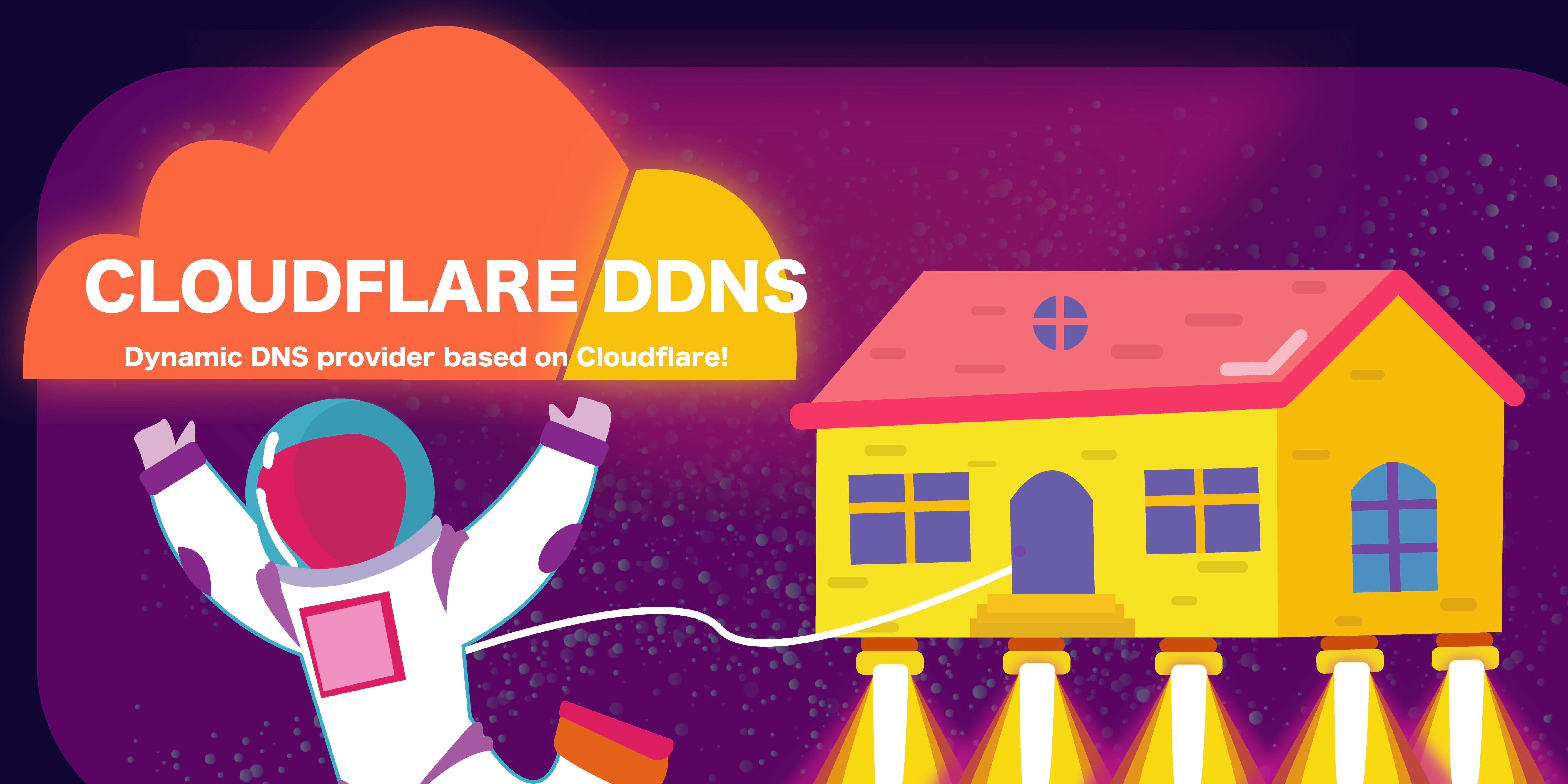Access your home network remotely via a custom domain name without a static IP!
A small, 🕵️ privacy centric, and ⚡ lightning fast multi-architecture Docker image for self hosting projects.
This script was written for the Raspberry Pi platform to enable low cost self hosting to promote a more decentralized internet.
cloudflare-ddns handles the busy work for you, so deploying web apps is less of a clickfest. Every 5 minutes, the script fetches public IPv4 and IPv6 addresses and then creates/updates DNS records for each subdomain in Cloudflare. Stale, duplicate DNS records are removed for housekeeping.
| Size | Downloads | Discord |
|---|---|---|
 |
 |
 |
- Uses zero-log external IPv4 & IPv6 provider (cdn-cgi/trace)
- Alpine Linux base image
- HTTPS only via Python Software Foundation requests module
- Docker runtime
- Open source for open audits
- Regular updates
First copy the example configuration file into the real one.
cp config-example.json config.jsonEdit config.json and replace the values with your own.
You can choose to use either the newer API tokens, or the traditional API keys
To generate a new API tokens, go to your Cloudflare Profile and create a token capable of Edit DNS. Then replace the value in
"authentication":
"api_token": "Your cloudflare API token, including the capability of **Edit DNS**"Alternatively, you can use the traditional API keys by setting appropriate values for:
"authentication":
"api_key":
"api_key": "Your cloudflare API Key",
"account_email": "The email address you use to sign in to cloudflare",Some ISP provided modems only allow port forwarding over IPv4 or IPv6. In this case, you would want to disable any interface not accessible via port forward.
"a": true,
"aaaa": true"zone_id": "The ID of the zone that will get the records. From your dashboard click into the zone. Under the overview tab, scroll down and the zone ID is listed in the right rail",
"subdomains": "Array of subdomains you want to update the A & where applicable, AAAA records. IMPORTANT! Only write subdomain name. Do not include the base domain name. (e.g. foo or an empty string to update the base domain)",
"proxied": false (defaults to false. Make it true if you want CDN/SSL benefits from cloudflare. This usually disables SSH)You can save yourself some trouble when hosting multiple domains pointing to the same IP address (in the case of Traefik) by defining one A & AAAA record 'ddns.example.com' pointing to the IP of the server that will be updated by this DDNS script. For each subdomain, create a CNAME record pointing to 'ddns.example.com'. Now you don't have to manually modify the script config every time you add a new subdomain to your site!
You can handle ddns for multiple domains (cloudflare zones) using the same docker container by separating your configs inside config.json like below:
{
"cloudflare": [
{
"authentication": {
"api_token": "api_token_here",
"api_key": {
"api_key": "api_key_here",
"account_email": "your_email_here"
}
},
"zone_id": "your_zone_id_here",
"subdomains": [
"",
"remove_or_replace_with_your_subdomain"
],
"proxied": true
},
{
"authentication": {
"api_token": "api_token_here",
"api_key": {
"api_key": "api_key_here",
"account_email": "your_email_here"
}
},
"zone_id": "your_zone_id_here",
"subdomains": [
"",
"remove_or_replace_with_your_subdomain"
],
"proxied": true
}
]
}Pre-compiled images are available via the official docker container on DockerHub.
Modify the host file path of config.json inside the volumes section of docker-compose.yml.
version: "3.7"
services:
cloudflare-ddns:
image: timothyjmiller/cloudflare-ddns:latest
container_name: cloudflare-ddns
security_opt:
- no-new-privileges:true
network_mode: "host"
environment:
- PUID=1000
- PGID=1000
volumes:
- /YOUR/PATH/HERE/config.json:/config.json
restart: unless-stoppedDocker requires network_mode be set to host in order to access the IPv6 public address.
From the project root directory
docker-compose up -dThis script requires Python 3.5+, which comes preinstalled on the latest version of Raspbian. Download/clone this repo and give permission to the project's bash script by running chmod +x ./start-sync.sh. Now you can execute ./start-sync.sh, which will set up a virtualenv, pull in any dependencies, and fire the script.
-
Upload the cloudflare-ddns folder to your home directory /home/your_username_here/
-
Run the following code in terminal
crontab -e- Add the following lines to sync your DNS records every 15 minutes
*/15 * * * * /home/your_username_here/cloudflare-ddns/start-sync.shCreate a config.json file with your production credentials.
The optional docker-build-all.sh script requires Docker experimental support to be enabled.
Docker Hub has experimental support for multi-architecture builds. Their official blog post specifies easy instructions for building with Mac and Windows versions of Docker Desktop.
- Choose build platform
-
Multi-architecture (experimental)
docker-build-all.sh -
Linux/amd64 by default
docker-build.sh
- Give your bash script permission to execute.
sudo chmod +x ./docker-build.shsudo chmod +x ./docker-build-all.sh- At project root, run the
docker-build.shscript.
Recommended for local development
./docker-build.shRecommended for production
./docker-build-all.shdocker run -d timothyjmiller/cloudflare_ddns:latestThis Template is licensed under the GNU General Public License, version 3 (GPLv3).
Timothy Miller
